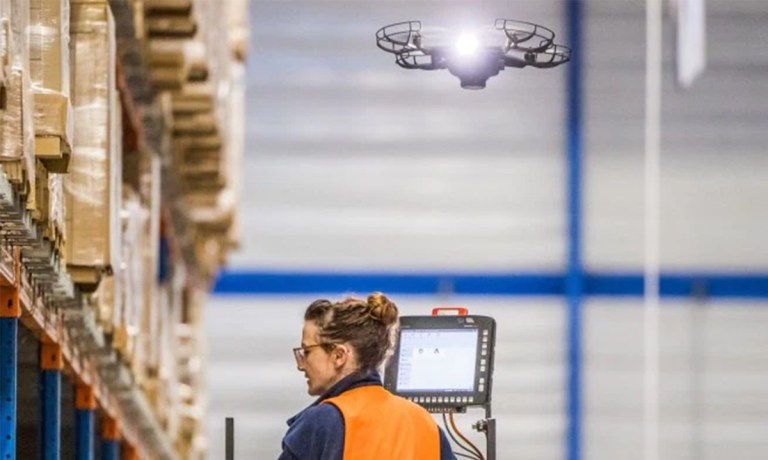
Forget Allen wrenches and wordless instructions. IKEA’s latest innovation comes with propellers and algorithms.
The Swedish furniture giant is taking to the skies — or at least to the ceiling — with a fleet of artificial intelligence (AI)-powered drones. Their mission is to conquer the chaos of inventory management in IKEA’s cavernous warehouses.
After a year of testing at its Winterslag, Belgium distribution center, IKEA is set to deploy these high-tech helpers to more locations over the next year. This move could redefine how retailers manage their stock and possibly how consumers shop.
“Drones equipped with RFID and barcode scanners are significantly improving inventory accuracy and reducing the time needed for stock checks,” Robert Khachatryan, founder and CEO of Freight Right Global Logistics, told PYMNTS. “For example, Gather AI’s drones collect data at a rate 15 times quicker than humans for specific tasks. Additionally, they can read 95% of the barcodes and labels found in warehouses, enabling managers to redirect human cycle counters to more valuable responsibilities.”
What began as a single drone in Switzerland in 2021 has quickly grown into a fleet of over 250, buzzing through 73 locations across nine countries. This expansion suggests that IKEA is betting big on this airborne inventory solution.
“The IKEA drones use an artificial intelligence-based algorithm to identify and photograph product storage locations,” Parag Parekh, Global CDO for IKEA Retail, said in a news release. These mechanical scouts navigate the towering shelves using a custom indoor positioning system, nimbly avoiding obstacles as they do their tasks.
The aerial revolution isn’t confined to IKEA. According to the 2023 Drone Market Report from Drone Industry Insights, the use of drones in warehouses is growing by 15.7% annually. Industry experts are noticing this trend’s potential to reshape retail operations.
This efficiency gain extends beyond retail. “Within the manufacturing industry, drones significantly speed up tasks like barcode scanning and stock tracking while reducing the risk of human error,” Shaun Wong, managing director of SLG Logistics, an international freight forwarder, told PYMNTS. “As a result, warehouses are seeing an increase in efficiency.”
For IKEA’s human workforce, the arrival of their robotic colleagues promises to change the nature of warehouse work. Gone are the days of scaling ladders and straining to reach high shelves. Instead, employees can focus on tasks that require a human touch, like customer service or complex problem-solving.
Across the retail landscape, drones are emerging as the new tool in the quest for efficiency. Amazon has long been testing delivery drones, while Walmart began experimenting with inventory drones in 2016. In China, JD.com and Alibaba have been pushing the boundaries of drone use in eCommerce for years.
The economic impact of this trend could be substantial. “The adoption of drones in warehouses can lead to a significant reduction in labor costs due to automation of routine tasks like inventory checks and stock management,” Khachatryan said. He adds a surprising environmental benefit: “Research conducted by the World Economic Forum indicates that drones have the potential to decrease energy consumption by as much as 94% in comparison to traditional vehicles.”
However, the drone revolution isn’t without its challenges. “As drones can perform tasks like inventory scanning or checking higher shelves much faster than humans, labor costs are reduced as fewer workers are needed for repetitive tasks. This will outweigh the initial investment,” Wong points out. But he cautions, “There’s a risk of job displacement as some workers may lose their jobs due to automation. Companies must find a balance by possibly retraining employees for other roles or managing a smaller workforce.”
Despite these concerns, the industry is moving full steam ahead. Khachatryan cites a Gartner report projecting that “by 2027, 75% of organizations intend to implement various forms of robotic automation within their warehouse operations.” This shift is already underway at IKEA, which is expanding its drone program to new locations, including the Distribution Center in Perryville, Md.
The future applications of these airborne assistants are expanding rapidly. “As drone technology advances, new applications are emerging, such as autonomous package delivery within large warehouses, monitoring warehouse conditions like temperature and humidity, and even performing minor maintenance tasks,” Khachatryan said.
Wong envisions even more possibilities: “Drones could be used for security patrols, transporting small items across the warehouse, or inspecting equipment. This would further streamline warehouse operations, reducing the need for manual checks and increasing overall productivity.”
The environmental impact is also noteworthy. Khachatryan points out that “electric drones and various warehouse robotics are integral to Amazon’s strategy to achieve net zero carbon emissions for all its shipments, with a target of reaching 50% of this goal by 2030.”